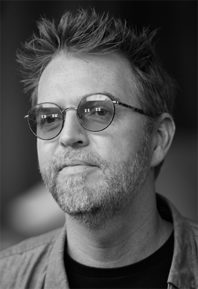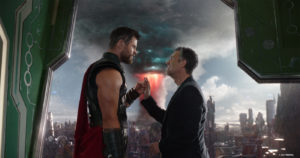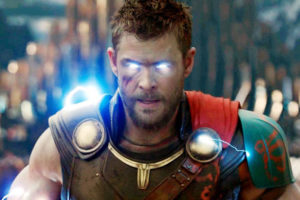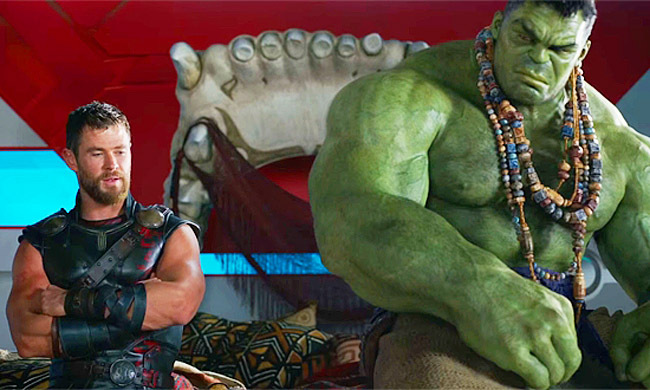
We can never discount the genuine effort that truly remarkable things can take…
Films from the Marvel Cinematic Universe certainly count in that category and in advance of the release of Thor: Ragnarok on DVD/Blu-Ray & 4K this coming March 6th we got the chance to talk with a key and creative driving force behind a lot of these films; Visual Effects Supervisor Jake Morrison.
We took a look at how many different disciplines come into play while making such a large effects driven movie like this while still maintain a degree of humanity inside all of the rampant creativity that these hard working men and women get to put on the screen…and so very much more as the art of painstakingly making sure that these spectacle movies don’t look too fake and engage with audiences on an emotional level comes to light.
Dave Voigt: So many people try to break into the industry in a myriad of fields and I’ve always been very curious to ask what the career path is for someone who wants to work in visual effects or really is there one?
Jake Morrison: It’s interesting because really that’s just one job title that describes about 15 different jobs. I would say that what we do generally speaking aside from what most people think that we do is everything really that falls through the cracks and not just nit picking of good pixels or bad pixels or anything silly like that. For example, if a few minutes before we go on set for a shoot, the director calls for some new kind of prop or has an idea for something that he wants to use, we obviously don’t have that and can’t necessarily build it on the spot so we’ll find something to use as a stand in, like the actor will be holding a pencil, or a bar of Toblerone and now it’s officially not on camera. Then when it gets to our stage we have to come up with a design that fits what they want, we have to physically build this prop and then put into the actors hand and then do all the visual effects stuff in composite. It’s really no different then something like city building or planet building on a big movie like this because there is only so much that you can build while you’re on set and in the moment and big films like Thor: Ragnarok can take up to two years from start to finish and things change and develop because you might have an idea or a clue what you’re going to do but it often changes at the end of the day. In many ways what are department is really is the director’s right hand in many ways because we can bring any ideas that come up along the way, on to the screen. I also work as a second unit director as well so it’s not uncommon for me to take a camera crew and go off somewhere and shoot extra stuff; like some of the flashback stuff that you see in Thor: Ragnarok. That’s a great example of how we are used to fill in the blanks where needed in on a picture like this and we are typically on for the entire run of a production from beginning to end, involved in as many aspects as needed.
DV: The worlds on Thor: Ragnarok are so colourful and vibrant but really never at all look ‘obviously’ fake. I’m quite curious about how meticulous the process of blending everything into one image has to be while putting it all together.
JM: I would say it’s pretty huge. The rule of thumb tends to be as follows; if you have any film where your spending a lot of time in one place, then that place would naturally tend to get a fair bit of love and attention if it’s a period piece or a drawing room comedy then you’ll be revisiting that set multiple times throughout and paying great attention to the set dressing and pouring a lot effort into that. A great example is from Doctor Strange and his sanctorum which was just absolutely stunning. However when you get into a situation like a Thor: Ragnarok which is for all intents and purposes a road movie, it’s truly the cosmic road trip just going from one place to another and given the time and the money constraints you just can’t build everything that you might need. Sometimes we’d find ourselves with a beautiful design that Dan Hanna our production designer would do and we’d build as much of it as was possible, meaning fit on the stage for that particular scene and then everything from there on out is all on us. Sometimes we done full set redressings on things that he has built and had to go in redo things because the set extension was just so big that we had to. Plus post production is always such a fluid process that if the director or the studio has an idea, we can’t really say “Oh it’s in the can we shot it months ago, we can’t go back” but instead it’s incumbent on us to just to keep working as the project evolves. On Thor: Ragnarok we had about 2700 shots which was about 98% of the movie go through the visual effects department. It’s just a massive undertaking.
DV: WOW…2700. Is that a standard number on a picture like this? Or is always evolving from picture to picture…
JM: You know I’d say it’s getting there. I don’t think it should be standard to be honest at least on the dramas or the romantic comedies but I’d say we’ve probably topped out at the biggest number yet for a Marvel movie so far. However as we go even further into the MCU with films like Black Panther & Avengers: Infinity War I have no doubt that our 98% will get eclipsed into the 99% in about 5 minutes (Laughs). The Marvel appetite is just huge and it shows on the screen, but to give you an example of something else right now I’m working on a picture called Jungle Cruise for Disney with Dwayne Johnson that has a real Indiana Jones type of vibe to it promises to have more things that are being built and in camera. Different films really approach things in different ways and I think it really all comes down to the appetite of the studio and the of course the vision of the director.
 DV: And again you can generate these splashy visuals that still really tie into the story like on Thor: Ragnarok or even something else you’ve worked on like Speed Racer is a job more engaging for you when you have more things to build from the ground up or is it better to just have a kind of baseline of things and they you just create from there?
DV: And again you can generate these splashy visuals that still really tie into the story like on Thor: Ragnarok or even something else you’ve worked on like Speed Racer is a job more engaging for you when you have more things to build from the ground up or is it better to just have a kind of baseline of things and they you just create from there?
JM: It can go both ways, sometimes it helps to have a clean slate but sometimes you just like finding something that you can build on top and it creates some pretty amazing things. For example on Speed Racer it was a largely green screen shoot but the creativity of it all really gets to shine through in the cracks when in a scene like in the Driver’s club which is this incredibly opulent club where he’s introduced to the head of the driving corporation, we played with so much. For example, when you defocus a camera you get these strange artifacts called ‘Bokeh’ which are these strange circles and ovals wherever you look at the shot and if you look at that scene we specifically shaped them into diamonds to make the whole thing look and feel more opulent. Ragnarok is almost done in the exact same fashion where everything that you see has been shaped to force the story because we had the flexibility there but if you look at the exact flip side of the equation and if you take a film that you shoot almost entirely ‘in camera’ there’s something really satisfying about getting to create things that the audience would never expect is you and that happens in almost every movie I’ve worked on. It’s really just a different set of tricks. It’s the difference between playing lead guitar or just playing an accompanist track, both are really satisfying if you’re a musician and the same is true in the visual effects realm.
DV: When you are building a shot in post, how conscience do you have to be of what the actor is doing and making sure that you aren’t necessarily taking away from anything that they might have done or is it something you feel that you can keep yourself separate from?
JM: Emmm, no. I mean I really feel that there is a time to be noticed and a time not to be noticed when you are doing this job so that is something that I really do consider very strongly. That manifests itself in the consideration and the conditioning of things on the screen and really through colour because yet another truly strange part of this job is how many aspects of filmmaking come into play, one of which is obviously cinematography. I’ve really found that I’ve become a student of how lenses work and how things draw the eye from one place to another. If you look at our films in black and white you can clearly see where the audience is supposed to be looking either by shadow depth of field or a high key light that might be touching someone in the face. There are really basic ways to take care of things like this and when you are working with a director, one of the first things I ask him is to find out how the audience should be feeling in any given shot. The mood is so important and I have to imagine that it is the first thing that the director of photography would ask; “What’s the mood of the scene, what’s the mood of the shot and where exactly should the audience be looking?” So when you start to build these visuals in the luxury of the post production that we get to play with and you look at any given shot in the way that you would if you were taking an art history course because there you are shown the way that you should look around the painting and the same is absolutely true when you’re building a shot for a movie. It plays different in a 3 second shot, versus how it would in a 20 second shot versus something like in the film Gravity where they had ten minute shots.
DV: And you know with these Marvel movies I really think that you guys have found that balance between spectacle and story and keep up the good work!
JM: Thank you so much that really means a lot and so much effort goes into the entire process, I mean on Thor: Ragnarok we were dealing with 18 different vendors for visual effects and we’d start our days talking with Germany, through to LA, both coasts in the US and places like Vancouver, Melbourne and so many others. It really does take a village as they say.
Thor: Ragnarok is available now On Demand and on DVD/Blu-Ray/4K on Tuesday March 6th.


